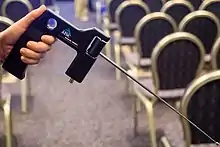C-FAST was a device purported to be able to detect infection with the hepatitis C virus (HCV) from a distance, using electromagnetic radiation emanating from the virus' genome. At a press conference in February 2014, Egyptian generals presented the device as a result of decades-long secret military research.
Device

The government of Egypt filed an international patent for the device in 2010.[1] The Guardian wrote about it in February 2013.[2] A report on an international study evaluating C-FAST appeared in 2013 in an online journal published by the predatory publisher WASET. According to this report, the device detected hepatitis C with high specificity and sensitivity.[2] The device was said to compare the received electromagnetic signal from a patient to the ideal signal emitted by a specific part of the HCV RNA genome that had been measured in a laboratory and stored on the device. If those signals agreed, the hand-held device would create a force, pointing the device's antenna towards the patient; if they didn't agree, no force was detected.[2][3]
The device's design and claimed method of action were very similar to those of the bogus bomb detection device ADE 651,[4] and it resembles a divining rod.[5]
Press conference
At the press conference on 24 February 2014, Egyptian major-general Ibrahim Abdel-Atti revealed the device, as well as a similar one ("I-FAST") for the detection of HIV infection. Both were adapted from a bomb detecting device.[6] Another device was announced at the presentation, the "Complete Cure Device" (CCD), which was said to operate similar to a dialysis machine, curing hepatitis C and HIV by removing the viruses from the blood.[6][7]
Field Marshal Abdel Fattah Al-Sisi, who had just been appointed Minister of Defense, attended the presentation, which might have had political significance, especially since Egypt has the highest rate of hepatitis C in the world and Al-Sisi was a candidate (and ultimately successful) in the presidential elections three months later.[7]
Reactions and further developments
Egyptian comedian, news commenter and physician Bassem Youssef mocked the devices on air.[8]
The CCD was planned to be rolled out in Egyptian army hospitals in July 2014, but in that month it was announced that this roll-out had to be delayed to allow for further testing. The claims about the devices were strongly criticised by doctors and scientists.[7][9]
References
- ↑ WO patent 2011116782, EBRAHIM, Ahmed, Amien, "FAST SERIES (FIELD ADVANCED SCREENING TOOL", published 2011-09-29{
- 1 2 3 Shiha, Gamal; Samir, Waleed; Azam, Zahid; Kar, Premashis; Hamid, Saeed; Sarin, Shiv (2013). "A Novel Method for Non-Invasive Diagnosis of Hepatitis C Virus Using Electromagnetic Signal Detection: A Multicenter International Study" (PDF). International Journal of Medical, Health, Pharmaceutical and Biomedical Engineering. 7 (12).
- ↑ Kingsley, Patrick (2013-02-25). "Scientists sceptical about device that 'remotely detects hepatitis C'". the Guardian. Retrieved 2022-06-06.
- ↑ "The $80 Million Fake Bomb-Detector Scam—and the People Behind It". Vanity Fair. 2015-06-24. Archived from the original on 2015-06-25. Retrieved 2022-06-07.
- ↑ Dickey, Nathan (2014-03-02). "Dowsing for Disease". Skeptical Inquests. Retrieved 2022-06-06.
- 1 2 "Egypt army criticized for claim of a device that cures AIDS". Los Angeles Times. 2014-02-28. Retrieved 2022-06-06.
- 1 2 3 "Public Health Upshots of Political PR - Egypt, HIV and Hep C". Borgen Magazine. 2014-03-19. Retrieved 2022-06-06.
- ↑ "Top Egyptian Comedian Slams Military For Saying It Can 'Cure' AIDS And Hepatitis C". HuffPost. 2014-03-03. Retrieved 2022-06-06.
- ↑ Iaccino, Ludovica (2014-07-01). "Egyptian Military Returns to Drawing Board With 'Miraculous' Cure for Aids and Hepatitis". International Business Times UK. Retrieved 2022-06-06.